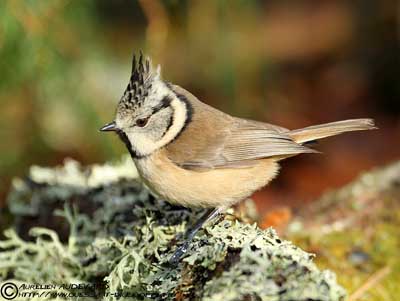
Crested Tit
Lophophanes cristatus
Passeriforme Order – Paridae Family
BIOMETRICS:
Length: 11-12 cm
Weight: 10-16 g
DESCRIPTION:
This small tit is always very active in trees, and unmistakable with its conspicuous crest. Very distinctive, this species has now its own genus “Lophophanes”, after long time in “Parus” with the typical tits.
Fr: Mésange huppée
All : Haubenmeise
Esp : Carbonero Capuchino
Ital: Cincia dal ciuffo
Nd: Kuifmees
Sd: Tofsmes
Photographers:
Aurélien Audevard
OUESSANT DIGISCOPING
Steve Garvie
RAINBIRDER Photo galleries
Jean Michel Peers
JMPN PHOTOGRAPHIE
Jean Marc Rabby
Des Ailes et des Plumes
Text and illustration by Nicole Bouglouan
Sources :
HANDBOOK OF THE BIRDS OF THE WORLD Vol 12 by Josep del Hoyo-Andrew Elliott-David Christie - Lynx Edicions - ISBN: 8496553423
THE HANDBOOK OF BIRD IDENTIFICATION FOR EUROPE AND THE WESTERN PALEARCTIC by Mark Beaman, Steve Madge - C.Helm - ISBN: 0713639601
THE COMPLETE BOOK OF BRITISH BIRDS – Written by “Royal Society for the Protection of Birds” experts - Préface de Magnus Magnusson - Michael Cady- Rob Hume Editors - ISBN: 0749509112
ENCYCLOPEDIE DES OISEAUX DE FRANCE ET D’EUROPE – de Peter Hayman et Rob Hume - Flammarion – ISBN : 2082009920
Avibase (Lepage Denis)
BirdLife International (BirdLife International)
Wikipedia, the free encyclopaedia
XENO-CANTO – Sharing Birds sounds from around the world

The Crested Tit adult male has grey-brown upperparts with slightly darker uppertail-coverts and paler or greyer upperwing-coverts. The alula and the flight feathers are darker grey to blackish, with fine grey edges on primaries. The tail is brownish-grey, finely edged grey-brown.
On the underparts, chin, throat and centre of the upper breast are black, whereas the breast sides are pale buffish-grey, as flanks and undertail-coverts. Rest of underparts are creamy-white.
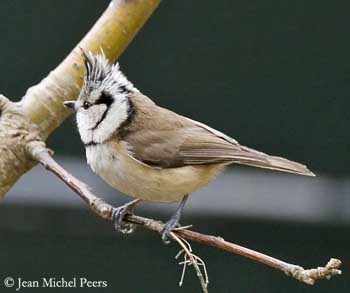
On the head, the pattern is black and white, and we can see a conspicuous short, spiky crest. The forehead, crown and crest are black with broad white feathers fringes giving a scaled effect.
The nape shows a narrow black vertical line which connects with a black collar on upper mantle. Lores, cheeks, ear-coverts and neck sides are creamy-white to white. A black eye stripe starts from the eye and runs along the rear edge of the ear-coverts.
The bill is black. Eyes are pale brown to deep red. Legs and feet are greyish to bluish-grey.
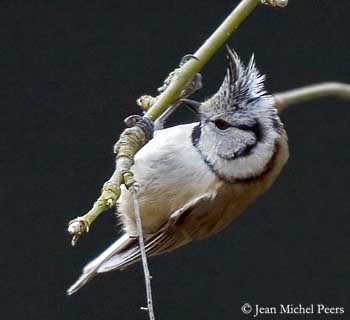
The female has similar appearance but she has shorter crest, narrower stripes on the head side, more buffish tinge on crown and crest, and darker flanks.
The juvenile resembles adult with shorter crest and browner crown and head pattern. The bib is browner.

We can find seven subspecies which differ in intensity of colours with brown to cinnamon tinge on the upperparts, paler or darker appearance and duller or brighter plumage overall.
VOICE:
The Crested Tit typical calls are thin, rising “zee-zee-zee-cheera-cheera” usually followed by low-pitched purring “brrrrr, t-brrrr” or “choorrr”.
We can also hear thin, high-pitched “see” sometimes in series, and a squeaky “sith-sith-silililili”.
The song is a rising and falling, purring “sih-hu-chorrr-sih-hu-chorrr-sih-hu-chorrr…” rapidly and frequently repeated.
HABITAT:
The Crested Tit favours the coniferous forests (Pinus, Picea abies, Pinus sylvestris) mixed with some deciduous trees, especially in the northern parts of the range.
In centre, south and south-west Europe, this species frequents a wide variety of habitats such as open woodland with dense ground layer, or shrubs with decaying trees and stumps for nesting.
Outside the breeding season, some movements occur to forage in other type of habitats, orchards, parks and gardens, and in areas with heathers and shrubs.
This species can be seen up to 600 metres of elevation in Scotland, 1800 metres in Austria and up to 1000-2300 metres in Balkans and N Greece.
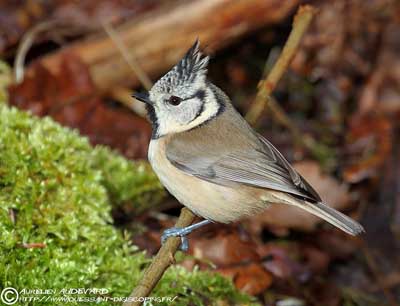
RANGE:
The Crested Tit is resident in its range throughout Europe, from W France and West and Centre Iberia, NC Scotland, N and E Europe S to Carpathian Mountains, SW and C Urals, C Europe S to NE Spain, Alps, Croatia and N Serbia, Albania, E to Bulgaria, and N and C Greece.
BEHAVIOUR:
The Crested Tit feeds mainly on small invertebrates and their larvae, spiders, and also some seeds and fruits outside the nesting period.
This small bird stores food all year round in holes and bark crevices. The food items are wedged in place, or can be covered with saliva or spider webs. Insects are often stored still alive but partly decapitated or paralysed. These stores are usually sited in the foraging areas and are often exploited by all members of the group during winter.
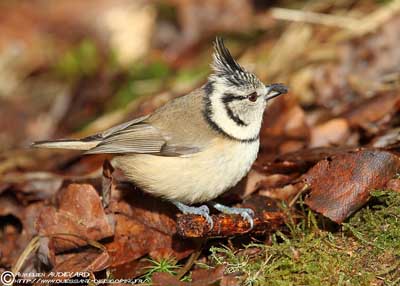

The Crested Tit is usually seen alone or in pairs, but outside the breeding season, they occur in small groups of 5-6 birds, with one or two mated pairs and juveniles. They can forage with other species such as other tits, treecreepers and goldcrests.
This species forages mainly high in conifers and in canopy during summer. After the breeding season, seeds and fruits are at lower level, in the undergrowth or on the ground. It can hang upside-down to extract seeds from cones, or occasionally hover in front of the vegetation.
As the Crested Tit is resident in its range, the territory is maintained and defended all year round. Courtship-feeding by male to female is the typical display, but songs and specific exaggerated postures are used to expose the head pattern by head-up displays.
The Crested Tit is resident but sometimes nomadic during winter. In the northern parts of the range, they wander up to 100 kilometres from the breeding grounds after the nesting period.
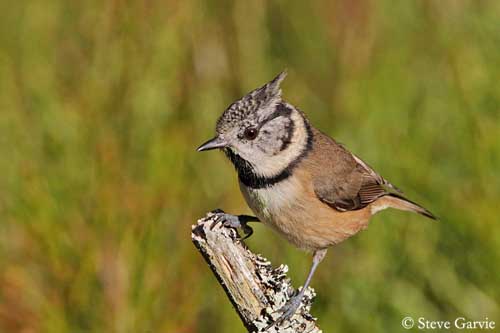
PROTECTION / THREATS / STATUS:
The Crested Tit is common or fairly common in most part of its range. It is local in Scotland and rare in Hungary.
These small birds are vulnerable to hard winters.
Some decline occurred due to changes in forestry practices, but the range has expanded in some regions due to increase and spread of commercial conifer plantations.
The Crested Tit is not currently threatened.
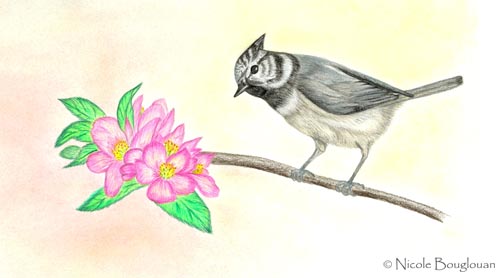
FLIGHT:
The Crested Tit hovers in front of the vegetation when foraging. It also performs short flights with rapid wing-beats.
REPRODUCTION:
The breeding season occurs between March and June.
The Crested Tit is monogamous and the pair-bonds are for long time.
The nest is situated in a hole in decaying or dead tree trunk, in branch or stump, but an old hole of woodpecker can also be used.
The pair excavates or enlarges the cavity and the female builds the nest, a cup made with moss and lichens, animal hair, wool, feathers and spider webs, at about three metres above the ground.
The female lays 5-10 eggs and incubates during 13-18 days. Both parents feed the chicks, mainly with spiders and some pine seeds. The young fledge 16-22 days after hatching and still depend on parents for food for 23-25 days more.
This species produces one brood per season, occasionally two.
The Great Spotted Woodpecker is the main nest predator.
DIET:
The Crested Tit feeds primarily on small invertebrates and their larvae such as damselflies and small dragonflies, stoneflies, mayflies, bugs, grasshoppers, moths, flies, small bees, wasps, ants, beetles and also spiders, earthworms and snails.
Outside the breeding season, it also consumes seeds of conifers, berries, sap of birch, aspen and maple, and some fruits.